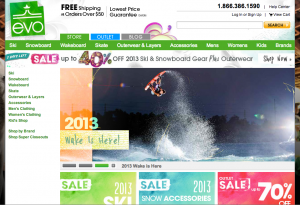Nathan Decker, Senior Director, E-Commerce for sporting goods multi-channel retailer, Evo, agrees that customer retention is part science, part art. In his morning session at eTail West 2013 yesterday, he discussed how Evo has grown using that theory, and particularly focused on the company’s email marketing experiences and learnings. Judging by his explanation, his customer retention strategy is much closer to a science with some artistic inspiration peppered throughout. 
First, Decker explained the evolution of Evo’s email marketing, stating that the first stage was more about initialization and the second more about optimization.
“We were able to segment with email, but not at scale,” he said. As the company increased frequency in its email send, just as many unsubscribes were coming in as new subscribes, therefore keeping the email file flat.
He told a story about his daughter who got away from him at the playground and within minutes, disappeared off the playscape. Terror set in as he was sure she’d fallen straight off. But luckily, he found her hanging from her shirt off a playful looking climbing wall and he thought, “That’s where we are with email marketing.” Evo was doing just fine, but it was just hanging there by a thread, and who knows how long the company would stay fine…
The second phase also offered Evo no email automation, and that’s when Decker started thinking bigger with email.
The third phase, which Evo said the company is in now, is more about retention and automation. Decker is now asking, “Can we stop sending emails to quite as many people?”
He’s discovering that through effective segmentation, and speaking to customers in a way that addresses their buying history and patterns, the answer is yes. Decker is testing winning by data vs. winning by content and hoping that in this third phase, the company will improve deliverability and get more engagement from customers.
The company started measuring its customer behavior based on three factors: R (recency), F (frequency) and M (monetary). By marking customers with these metrics, Evo created segments such as R1F1M1, meaning the customers in that group rank first in terms of the recency of their last order, first in terms of how frequently they ordered, and first in terms of how much money they spent with Evo.
“The R1F1M1 segment is a very tiny segment of the customer base but accounts for a huge amount of revenue, so we want to treat them differently than our other customers,” said Decker.
Customers in that first tier group are messaged differently than those who, for instance, are in the “churning segment,” R4F1M1 – which means that they haven’t ordered in a long time (fourth in terms of recency), but when they did order, they were a frequent purchaser and they spent a lot of money.
“We’re going to talk to them about coming back,” said Decker.
Confused?
Truthfully, the concept is pretty simple and sets up a great template for how to best message customers based on behavior, which is the best test of how they will respond in the future.




Recent Comments